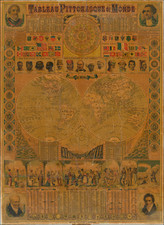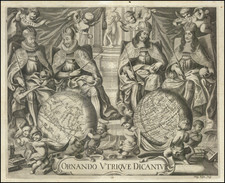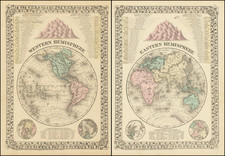One of the Earliest Hints of the Australian Subcontinent
An early state of the Arias Montanus map of the world, first published in 1572.
The present map is one of the most recognizable and finely-composed World maps of its era. With text written variously in Hebrew, Greek and Latin, its primary purpose was to show the Biblical concept of the distribution of the Twelve Tribes of Israel throughout the world, repopulating the earth following the Great Flood by the descendants of Noah.
Geographically, Montanus depicts a land bridge between Asia and the Northwest Coast of America, supposedly used by the biblical figure Ophir, who was said to possess endless treasures (in this case referring to the vast amounts of gold and silver found in the Americas). A large land mass roughly occupies the position of Australia, making the first issue of the map one of the earliest to depict an image which has been claimed by some scholars to be a depiction of Australia based upon sources pre-dating the known Dutch Voyages which are known to have reached Australia.
This double-hemisphere map was widely admired in its time for its artistically virtuous design, with its Mannerist strapwork cartouches and the encircling Renaissance-style windheads.
The map was first published in 1572 by that city's preeminent printer, Christoph Plantin. Plantin, who was famously the publisher of Abraham Ortelius' Theatrum Orbis Terrarum (1570), the first modern atlas. Antwerp, which was then in the Spanish Netherlands, was on the fault line of the religious schism between Catholicism and Protestantism. Plantin, who was rumored to harbor Protestant sympathies, was concerned that the Spanish authorities would censure him. In an effort to head-off the government's suspicions, he worked with a Spanish prelate, Benito Arias Montano (Benedictus Arias Montanus), to publish a polyglot bible dedicated to Philip II, Biblia sacra hebraice chaldaice, graece et latine (known as the Biblia Regia). The world map, which its strong religious overtones, was prepared to accompany this work.
The map was widely admired throughout the succeeding century. Around 1660, the map was entirely re-engraved in London, and included in an important biblical work, Critici Sacri, sive doctissimorum virorum in SS. Biblia annotationes & tractatus, which appeared in several editions from between 1660 to 1690.

![(World - First State!) Benedict Arias Montanus Sacrae Geographiae Tabulam ex Antiquissimorum Cultor. [Pre-Dutch Discovery Depiction of Australia] By Benedictus Arias Montanus](https://storage.googleapis.com/raremaps/img/small/93232.jpg)










![Tabula Terre Nove [The Admiral's Map]](https://storage.googleapis.com/raremaps/img/small/81714.jpg)

![Hemisphere Occidental ou du Nouveau Monde . . . [and] Hemisphere Oriental ou de L'Ancien Monde . . . MDCCLXI](https://storage.googleapis.com/raremaps/img/small/64273.jpg)
![Typus orbis descriptione Ptolemaei [Verso title]](https://storage.googleapis.com/raremaps/img/small/103829.jpg)